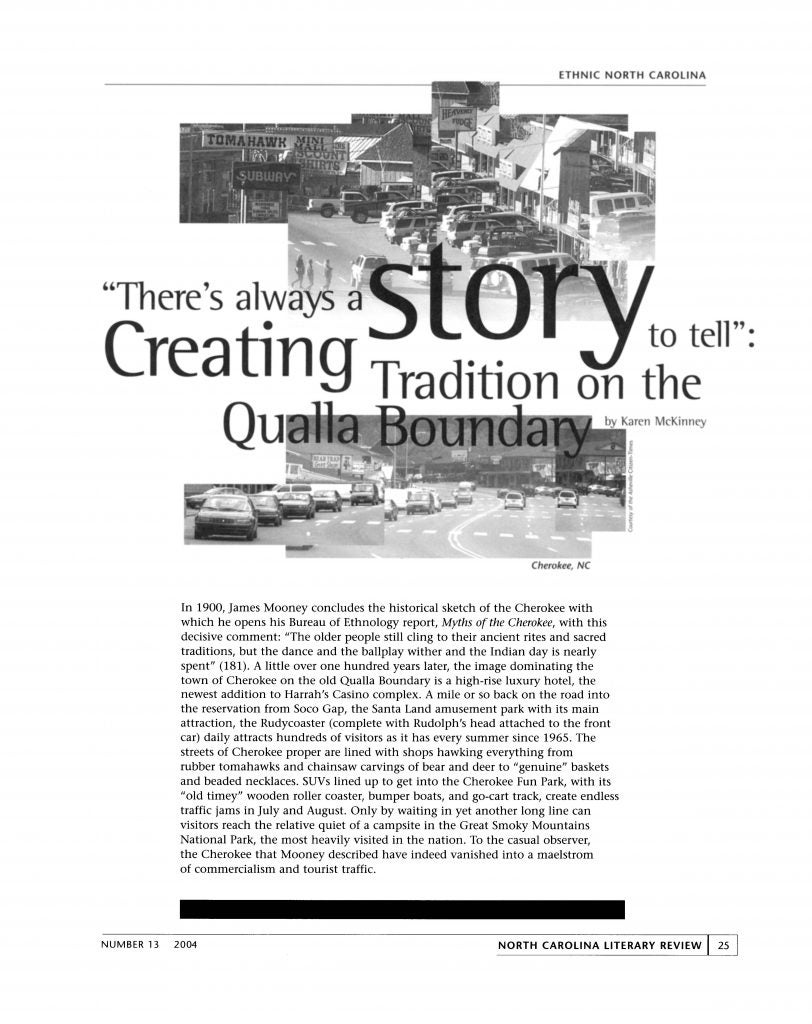Friday from the Archives: “There’s Always A Story To Tell: Creating Tradition on the Qualla Boundary” by Karen McKinney from NCLR Issue 13 (2004)
While the 2023 issue will be the first to specifically feature the writings of and about our NC indigenous communities, we have published related pieces in the past. McKinney’s essay on the autoethnigraphic writing happening in the Qualla Boundary was part of our feature on Ethnic North Carolina twenty years ago.
McKinney sets the context for the first book of stories she shares by starting her piece with the visits of tourists to the town of Cherokee, then into talking about the stories of the Little People visiting the Cherokee people, as written in the Stories of the Yunwi Tsunsdi. She writes, “The most remarkable aspect of Stories of the Yunwi Tsunsdi is that the contributors’ continuing belief in and day-to-day experience with these supernatural creatures is not placed in a patronizing or coldly clinical context by those who collected the stories and assembled the collection… What emerges is an example of Cherokee literature that is as traditional as the story of Selu’s gift of corn but unashamedly a product of the late twentieth century.”
Furthering the contemporary story-telling, McKinney writes about Debora Kinsland Foerst’s master’s thesis “Do You Just Say My Words?” about the gift of crafting both individual and community stories to share personal history. McKinney observes, “In the twenty-one portraits that follow, Kinsland’s overarching intent to capture the act of storytelling on the Qualla Boundary in all its variety of content, setting, and purpose emerges, while more of her own technique becomes evident.”
“Cherokee culture and tradition, Kinsland is saying, is alive and well, taking in new elements while retaining essential traditional ones, embracing change rather than trying to build a barrier against it,” McKinney finishes her essay. “Whether the story is told by elders before a cabin fire or by school children under a backyard trampoline, orally or written as a short story, the teller communicates origin myths, history, wisdom, and humor to her audience – and the mysterious experience of human culture in its Cherokee expression continues to perpetuate itself against all odds.”
Applying her ethnographic training to all her teaching work around the globe, McKinney taught in Istanbul before 2020 and “noticed some interesting commonalities in Turkish and Kurdish culture with Appalachian culture, and I hope to write about this in some form.” During the pandemic she moved home to the Blue Ridge Mountains, but she hopes to return to Turkey before long.
We are excited now, twenty years later (yes, too long), to feature Cherokee, Lumbee, and other NC tribal literature and artists. Subscribe today to receive the 2023 issue this summer.
Read the whole essay in the 2004 issue, featuring “Ethnic North Carolina,” now available on Gale Literature Resource Center (via NCLive). You can still order the issue for your collection.
